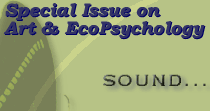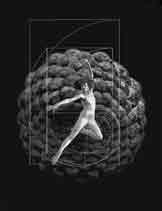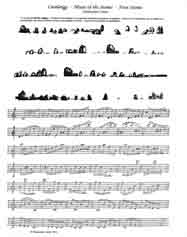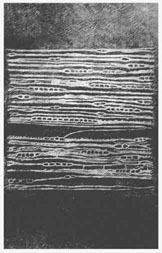

 |
 |
 |
 |
|
Interview
with Environmental Artist/Visionary
The
following article uses excerpts taken from a several-hour interview/conversation
I had with the English-born artist in his home on April 1st, 2000.
Christopher lives in the California bay area with his partner, Kathryn
Roszak, and their year-old daughter, Lucy. Together, they form the
nucleus of "Anima Mundi", a performance group in which
Christopher composes the musical score and designs the visual backdrops
for Kathryn’s choreography and dance performance. Part
1 of this interview appears in the Image
section of this issue. Introduction Interview C)
I guess what I am trying to do is to uncover patterns that may not
be obvious, to reach down into pattern, and try and get at the source
of what is making this patterning. … And dance with it (laughs);
that’s the fun part. Sometimes it’s a lot of work getting
there, but it’s always a great pleasure." A) Because if you can once find that pattern… you can see it anywhere… it can translate from the smallest part of anything… like fractals?" C)
Yes! Well, this all came about… let’s retrace our steps
a bit here. It was back, just about the time I came back from Poland.
I made a visit to a stone circle, Castlerigg, in the Lake District.
Have you been there? It’s one of the most beautiful sites in
Britain. I’d been there a number of times before, but on this
occasion I was going with a friend of mine (from the original group
of "Earth Mysteries" artists of the 60’s and 70’s)
- he was a teacher and had brought a group of his students from
the American School in Germany where he taught. Anyway, we went on this tour with him to all these sites, this ‘mad’ sort of camping trip, and one of the stops was Castlerigg. We’d camped down in the campsite below, and overnight this horrendous snowstorm happened. Our tent blew over and we were trying to hold it up, snow swirling around… it was amazing! This was in late Spring… kind of late for snow, but it happens. And then in the morning, we got up early and decided we were going up to the stone circle. We walked up there and the whole place was just a complete whiteout. |
|
|
At
that point I saw these stones, which were black silhouetted forms
against the white—you couldn’t see the landscape; snow
was blowing horizontally, there was ice everywhere; it was one of
the coldest places I’ve ever been. You could just barely see
the stone circle in this white-out. I looked about me, and just
felt; "this is laid out according to some musical plan."
Later,
I began to think more about this. I thought "I can do something
with that idea and actually turn it into music, meditation, by measuring
the distances and heights and stones." And I did that; I did an etching, based on that (my survey). I think it might have been up on the wall when you were here before. It’s an etching which has a watercolor on the top, of a landscape - mountains and the stones, very small, stretched out as a panorama - and below it is a diagram of the same stones, diagrammatically (schematically) drawn. And below that a musical line, showing how the stones define a line of music, and below that another musical line showing the spacing, and defining a timing for the music. And then finally below that, a sort of triangular arrangement of the notes, separate notes, each one signifying one of the stones. |
|
|
My
idea was that there were 39 stones in the circle, and this should
be a piece for 39 voices or instruments. Each voice would take a
single note or stone. The the (delete repeated the) one that defines
the central axis of the circle would come in first, and then each
additional one would be added progressively in a great crescendo
of roaring energy until you had the whole circle, humming. A)
Did you ever perform it? C)
Oh yes. (laughs) A)
And…? C)
Well, there’s a little break between the conception and its
actual performance. It stayed as a piece of music on paper for quite
a while - I played around with it myself instrumentally and we had
various ideas about performing it at the site, but it never really
happened. Then, much later- about 1990, when I came over here to
the U.S. - I met a friend who had a whole ‘midi’ thing
set up - with his synthesizer linked to his computer - and he suggested
"why don’t we put this music into the system, and see
what we can do with it?" "Great," I thought, and
so we fooled around, put it in, and I discovered that this piece
actually sounded—and I don’t know how familiar you are
with English composers - do you know Edward Elgar? Well. this piece
sounded, when we put it at a certain register… it was like
a rich cello sound, incredibly like Edward Elgar- a theme very romantic,
a flowing kind of theme. Quite extraordinary. So I felt, "Hmmm,
this is a very odd phenomenon…" A) Yes, linking the music right back to that landscape… Music of the Stones: Score © Christopher Castle C)
And so we composed several pieces, based on this single theme. I
developed it so that it included a lot more of the landscape - the
hills and the trees you can see from the center of the circle as
you turn around - you get all this texture and shape going on. So
I incorporated all that as separate lines of music, giving myself
a little more to play with. So, I had these drawings showing all
that, and the music itself, taped, and then we actually played it
as a part of my getting together with Kathryn and her choreography.
We put on this piece called Anima Mundi—which gave rise to
our company name—at Grace Cathedral, in San Francisco back
in 1993. The performance included a whole series of pieces I’d
written by that time, the first one of which was this ‘Music
of the Stones’, as it was called. As it turned out, we used
it as a theme to describe magma. Particularly the crescendo that
I mentioned, the adding in of the deep notes, and we played that
on the organ in Grace Cathedral on the lowest register. We had that
whole building just throbbing with the pulse of low notes of the
organ (laughs). As we rehearsed that in the cathedral vergers were
seen running up and down the side aisles with their robes flapping
in alarm. Kathryn
choreographed some incredible movements to that piece of music…
let me illustrate this a little bit. This is some of the imagery
we used… (shows me some images) This is the Music of the Stones
- one of the versions, the central piece of the one we did at Grace
Cathedral, the one we played on the piano. It’s called Four
Stones. What it is, is four stones (i.e. four notes), semi-quavers,
at a time played four times, then moving on one stone. Each quadruplet
takes on the next stone, dropping the first, and rolls around the
circle. It is played very, very rapidly. It’s quite amazing.
Then this is the organ piece, and the circle itself played on the
cello… Following on from that, I realized this idea can be applied really to any pattern. So I took… I wanted to use organic pattern, as part of the sequence we were working on for Anima Mundi … So, I used a redwood root cell pattern, a layout of the cells, using the spacing of the cells as rhythmic notation … and developed a percussion piece from that. I called it Sequoia Xylem and Phloem – the xylem is the hard material of the cell pattern represented musically by the percussion, while the phloem is the soft, liquid, life force, that flows through the cells, represented musically by a smooth ‘cello version of the notation. The two work together quite amazingly.
'Roots' © Christopher Castle A)
Was this all part of the Anima Mundi performance? C)
Yes, it was. It was another dance that goes with that original piece;
it was really fantastic, two dances, actually, inter-twined in a
very sensual ‘root-like’ piece. The sequence with Anima
Mundi goes through a whole journey; from deep in the earth, through
the biological level, into the animal and human, shamanic kind of
level. And then—because we were in Grace Cathedral—we
wanted to add a religious motif that would kind of link in with
it, so of course there was the Black Madonna. (Read more about Christopher’s
experience with the Black Madonna in Part 1). Kathryn did a dance—a
Black Madonna piece—that was not to my music, she used a very
apocalyptic Medieval piece called the Song of the Sybil. And then
we did one piece based on star maps. These are some of the costume
designs for the shamanic human dance, and the dancers dancing it
(shows me images). Finally there were angels. So again the motif
is a transformational sequence from base metal, as it were, to gold. A)
Did you find a pattern in the icons that you could map this sort
of music to…? C)
No, I haven’t done that; not yet. Maybe that will come…
That’s an interesting idea... But
Kathyrn actually worked with this Latin text, which is sung. Most
amazing. It’s a very prophetic piece about judgement and God,
hell-fire and damnation kind of thing. Lamentation and gnashing
of teeth. Kathyrn based her dance for this on a lot of these kind
of shapes from Byzantine icons… (shows me images). A)
How brilliant that you can do this sort of collaboration together,
and be inspired from each other’s work. C)
Yes, it’s great. It’s very difficult to do that sometimes,
when you’ve got all the rest of life going on, but that’s
how we started out together. This
is one of my stellar maps converted into music… What I did
was take the Southern Hemisphere of Stars, a circular map, and put
a pin in the middle, at mid-heaven. Then I divided the height from
horizon to mid heaven into 90 degrees, each of which were 90 separate
semi-tones of music on a vertical scale. And then going around horizontally,
it took 360 degrees, so there were 360 beats, you could say. So,
measuring off, as we went round - you take a pin and a piece of
string and move the string round; as the string coincides with stars,
you mark it off, as a note. So you go around 360 degrees, and each
one of these notes represents a star. I took four different magnitudes
of star- each magnitude has its own voice- so it wasn’t totally
cluttered into a single voice - it’s a kind of clear and brilliant
music. A)
Do you use different instruments for these different voices? The
Star Music also got incorporated into a poem written by Kathryn’s
mother, Betty Roszak, who is a wonderful poet. In fact, it was partially
commissioned by her for this purpose. She took different pieces
of music created from this score, and did a whole edited version
with her poem. The poem, called Starbirth, is about the explosion
of a super-nova. It’s a really cosmic piece. What I did was
take these same notes and put them through a lot of changes on the
computer - different tempos and using different edits to create
different effects. Of course we had the whole scale, from the lowest
note on the piano to the highest, so you have an enormous range
of notes there to begin with. Then I would take sections of it,
and play with those—create different kinds of effects; roaring,
rolling, high pitched sparkling; different amazing effects. So,
it turned out that I got a whole suite of pieces from just this
one exercise with the stars. Back
to the Anima Mundi piece - Kathryn choreographed two of those star
pieces, one of which became part of Anima Mundi as well, so we’re
going from deep in the earth into the stratosphere here. And then
there was a section on angels - the stars sort of turned into angels,
you could say. A)
It sounds to me like it WAS the Universe! (laughs) C)
Yes, right. Anyway, he definately couldn’t handle that, so
we had to go through some back doors, and really we worked for about
two years to get this piece put on there. A)
Ah, but what a great venue, what an incredible place to put it on.
I think it must have been worth all your trouble. C)
Yes, we packed the place, which was very gratifying. Since
Anima Mundi in’93, we continued with the environmental themes
and have performed all over the place. We did a major project called
Deep North with Sami musician Ingor Annte Ailu Gaup which took us
on two journeys to Arctic Norway to collaborate with the indigenous
reindeer herding people on an evocation of Arctic culture. We performed
this work at La MaMa Experimental Theatre Club in New York City.
Another major work was for the Marija Gimbutas conference at the
Smithsonian Institution. Then we were asked to appear at Frank Lloyd
Wright’s Taliesin West for their international gathering of
Architects at their 60th Anniversary reunion. We also collaborated
at the Copenhagen European Cultural Capital festival with a French
mathematician, Francoise Chatelin. We created a piece called The
Mathematics of Life. Her original text, a lecture on number theory,
complexity, provided the basis for an exploration of the desacralization
and resacralization of numbers. The work included a multi-media
blend of theatre, dance, music, projected slides and video, sacred
geometry and humor! Find out more about Christopher Castle and how to contact him at the end of Part 1 of this interview. Most recently, Christopher and his life/work partner Kathryn Roszak have been creating more multi-media productions with their performance group Anima Mundi. I was lucky enough to be invited to a work-in-progress performance of their latest piece, Mountains and Rivers without End, based on environmental poet Gary Snyder’s autobiographical series of poems. This performance is reviewed in the Movement section of this issue. |
|



